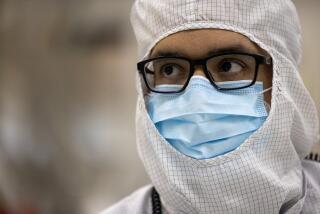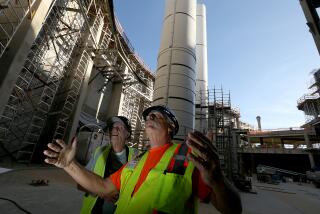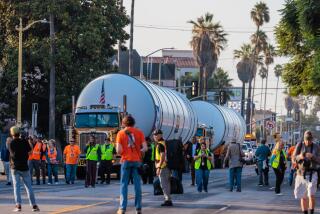Waiting, Hoping --And Testing : Shuttle Downtime Allows Extensive Trials of Vital Engine in Santa Susana Mountains
- Share via
With increasing frequency, an unearthly roar is splitting the silence in the hills around the West San Fernando Valley.
The sound, accompanied by a sputtering bright glow in the Santa Susana Mountains, has elicited occasional letters to newspapers and calls to the police.
It is the sound of 12 million horsepower.
At a 3,000-acre site in the mountains, the main engines of the space shuttle, the trio of nozzles that sprout from the rear of the craft, are being tested at a quickening pace as NASA tries to get its crippled space program back on track.
In the last few months, Rocketdyne, the engines’ Canoga Park-based manufacturer, has doubled the rate of testing as new features, designed to make the engines safer and more durable, are assessed.
The schedule has accelerated to keep the shuttle program on track for a hoped-for February, 1988, launch. Twelve to 14 engine-test firings are taking place monthly at two test ranges: the one in the Santa Susanas above Canoga Park and one in Mississippi.
The mountain test range has been silent for two weeks as a new engine has been moved to the test stand, said a spokesman for Rocketdyne, a division of Rockwell International Corp. The new engine will undergo a near-instantaneous ignition test Monday. Weekly tests, most lasting about three minutes, should resume in about 10 days.
In each test, an engine, tethered to a metal stand, roars to life and strains against its bonds, simulating the rigors of flight. Each engine produces as much power as seven Hoover Dams.
The engine tests are a small but crucial part of a massive program, overseen by the National Aeronautics and Space Administration, to reduce the risk of equipment failures that could produce a catastrophe like the one that destroyed the shuttle Challenger on Jan. 28, 1986, killing seven astronauts.
Engineers are using the two-year hiatus caused by the Challenger’s loss to test and incorporate about 400 changes in the overall design of the shuttle before the next launch, said Joseph Lombardo, project manager of the space shuttle’s main engine-projects office at the Marshall Space Flight Center in Huntsville, Ala.
“Since we have this downtime . . . we’re taking the opportunity to incorporate all those changes in one lump sum,” Lombardo said. Before a shuttle flies again, anything that can be fixed must be fixed, he said.
Several modifications to the main engine design that are expected to improve reliability and durability are being tested, he said. The test engines are run on the ground at least twice as much as any engine has ever run in space, Lombardo said, providing an early clue to any deterioration of parts long before it might show up during a mission. “We don’t baby the ground-test hardware . . . and say, ‘Look at all these great tests we ran,’ ” he said.
Such tests have been performed throughout the shuttle program, but the current grueling pace has not been seen since the early stages of development of the shuttle in the 1970s, he said.
Even with the accelerated testing rate, most space officials feel that the planned Feb. 18, 1988, launch date is optimistic. Many doubt that all the changes in the engines and the other systems can be tested and incorporated into the fleet by that time.
Lombardo visited Rocketdyne a week ago for the latest round of what he calls NASA’s “re-review” of all shuttle systems. Contrasted with the changes planned for the spindly pair of solid rocket boosters that caused the Challenger catastrophe, the subtle modifications deep in the main engines seem minor, Lombardo said. But, he added, “Nothing in the main engines is minor.”
The shuttle has seven engines in all: the two immensely powerful solid rocket boosters, the three reusable main engines, and two small engines that provide a small boost into orbit and are used for maneuvering.
The two solid rocket boosters burn only for the first two minutes after a launch. Only the three main engines burn throughout the nearly eight-minute trip into space, lofting the shuttle free of Earth’s atmosphere and into orbit.
These remarkable power plants, the only large rocket engines ever built to be reused, are the heart of the shuttle.
When asked to compare the design of the shuttle’s main engines to other designs, Robert Paster, director of the main engine program for Rocketdyne, spouted superlatives: “It’s the highest-technology, the most powerful, the most efficient. . . . There is still no engine anywhere around that can do what this engine can do.”
Since 1971, Rocketdyne has employed close to 3,000 people and spent several billion NASA dollars to design and manufacture the main engines.
A Break With Tradition
When NASA approved Rocketdyne’s design, it was breaking radically with tradition. For decades, rocketeers had relied on expendable rockets, tubes full of fuel that burn out like fireworks, then disintegrate when they fall back into Earth’s atmosphere.
For the first time in history, scientists had conceived of a rocket engine that would be used over and over again. Paster said that the original design, now nearly 15 years old, has held up well even as technology has progressed.
The engines are subject to changes in temperature and pressure that are found almost nowhere on Earth. The liquid hydrogen fuel and liquid oxygen stored in the bulbous external tank--both maintained at temperatures hundreds of degrees below zero--vaporize, combine and explode in the heart of each engine, producing a temperature of 6,000 degrees Fahrenheit.
In hangar-like buildings that sprawl across 56 acres of Canoga Park, these machines are painstakingly built--it takes four years to complete one--from more than 30,000 parts composed of 103 metals and other materials.
Some parts are actually “grown” molecule by molecule, as pure nickel is deposited from a solution onto the part and built up to a thickness of as much as three-quarters of an inch.
Welding Instead of Bolts
The major components of the engine are welded together, producing a seamless, leak-proof product that is 1,500 pounds lighter than if fastened together with bolts, according to Rocketdyne engineers. Most of the welding duties were recently transferred to computer-controlled robotic welders. And sophisticated probes are now inspecting welds in the deepest recesses of the engines.
The heart of each main engine is a tightly packed mass--about five feet tall and six feet across--of welded alloy turbines, tubes and chambers. Simply put, each engine consists of two pairs of pumps that force the half-million gallons of super-cold liquid hydrogen fuel and liquid oxygen stored in the shuttle’s bulbous external tank into a series of chambers where they vaporize, combine, and explode into a column of raw power.
For both the oxygen and hydrogen, a low-pressure pump provides an initial boost in speed and pressure, and a high-pressure turbopump accelerates the gases the way a jet engine sucks in and expels air. It is the high-pressure pumps that are undergoing the most changes.
The entire system sits atop a nine-foot-high conical nozzle through which, at its peak, each engine expels 500,000 pounds of thrust. The three engines together produce the equivalent of 37 million horsepower.
Every system in the engines is designed for efficiency. For example, some of the hydrogen fuel, before being burned, is circulated through the walls of the combustion chamber and nozzle to keep them cool. Otherwise, they would be incinerated by the heat, 6,000 degrees Fahrenheit, of the exploding gases.
Most of the planned changes will be made in parts of the oxygen and hydrogen turbopumps. The turbopumps were originally designed to last through 55 flights before they needed replacement or repair. But, because of unexpected wear, they are now only lasting the equivalent of four or five flights in tests, according to NASA spokesmen.
Tiny Cracks Discovered
In some test engines that have run for the equivalent of many flights, tiny cracks have developed in the fast-spinning turbine blades, and ball bearings have shown signs of wear, Lombardo said.
Both in the oxygen pump and the hydrogen pump, the turbine blades, metal fins the size of a matchbook, will be modified. But it is a testament to the complexity and subtlety of the engine that the changes must be different for each turbopump.
The 122 blades in the hydrogen pump seem to be made brittle by exposure to the hydrogen fuel, Paster said. This poses a danger that a blade could crack and fly away from the shaft, with disastrous consequences.
Rocketdyne is testing several modifications of the hydrogen turbopump blades. Some blades are pummeled with tiny particles, a process that is thought to make the surface more resistant to the effect of the fuel. Other blades are plated with a thin layer of gold.
In the future, the material from which the blades are made may be changed, Lombardo said. Rocketdyne engineers are studying the possibility of making the blades from individual metal “crystals,” grown to the appropriate size and milled to shape, he said.
Other problems have cropped up in the oxygen pump. The 155 blades have a natural tendency to vibrate as the oxygen passes over the surface, Paster said. Modified blades incorporating a damping mechanism that absorbs any growing vibrations have undergone 5,000 seconds of test firing and look “very good,” he said.
Because almost anything, if it gets hot enough, burns in the presence of oxygen, another problem is that, after many test firings, the 50 hardened-steel ball bearings that allow the turbine to spin freely tend to wear and discolor.
When test engines that had gone through the equivalent of many flights were dismantled, engineers noticed a change in the ball bearings, Paster said. The bearings came out various colors: silver, gold, brown or gray, he said.
Understanding the Message
Now, after test firings, the turbopumps are being disassembled and the bearings put through careful chemical analysis, he said. “We want to understand the message this hardware is giving us. . . . Is this wear and coloration indicative of some marginal condition, or is it a tolerable condition?” Other types of ball bearings may be tried if the condition is found to be unacceptable, he said.
Several reviews of the test results will take place this year, with certification of any changes taking place before the next launch, Lombardo said.
It appears that NASA approves of Rocketdyne’s work. The space agency just awarded the firm a $200-million contract to produce engines for a shuttle that will replace Challenger, returning the active fleet to four spacecraft. The first $4.5 million is already being spent on the engine parts that take the most time to build. The rest of the contract will be awarded in August.
More to Read
Sign up for Essential California
The most important California stories and recommendations in your inbox every morning.
You may occasionally receive promotional content from the Los Angeles Times.










